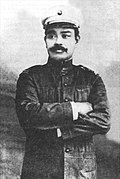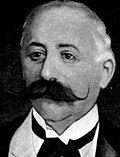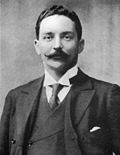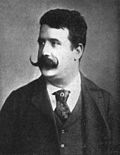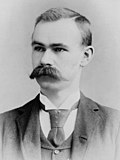History
Similar styles of moustache are quite ancient, appearing on statues and other depictions of Iron Age Celts. [5] In the United States, handlebar moustaches were worn in the later part of the 19th century by Wild West figures like Wyatt Earp. [6] [7] In Europe, handlebar moustaches were often worn by soldiers during the 19th century until roughly the era of World War I.
English comedy actor Jimmy Edwards grew his trademark handlebar moustache in the late 1940s in order to disguise facial injuries sustained as a pilot in World War II. [8]
In 1972, to win a $300 "best facial hair" prize offered by team owner Charlie O. Finley, Oakland A's pitcher Rollie Fingers grew a handlebar moustache which he sported throughout his career. [9] [10]
More recently, the contemporary hipster subculture has embraced the handlebar moustache by mocking conventional ideals of fashion, and by combining a highly manicured handlebar moustache with the portrayal of an unkempt appearance or a haphazardly selected clothing ensemble. [11]
Famous handlebar moustaches
This page is based on this
Wikipedia article Text is available under the
CC BY-SA 4.0 license; additional terms may apply.
Images, videos and audio are available under their respective licenses.




















